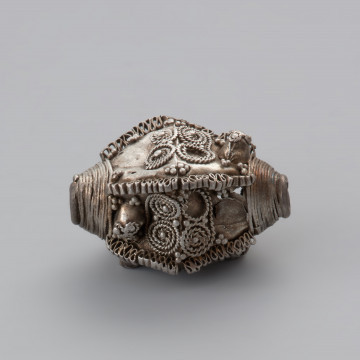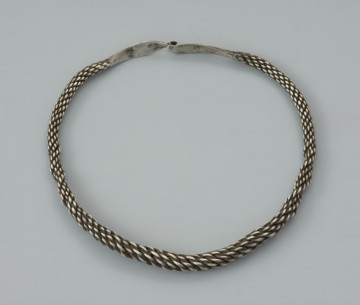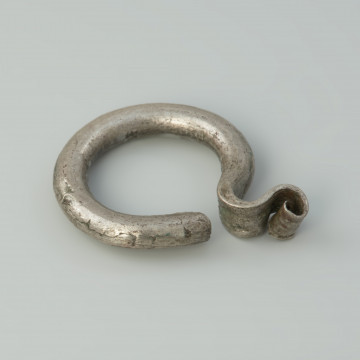
Silver bead
951 — 1000
National Museum in Szczecin
Part of the collection: Middle Ages
A silver pendant from a hoard discovered during agricultural works in 1859 in Kurów, Koszalin district, is an element of a hoard with silver coins and ornaments from the end of the 10th century, which was found in a clay vessel. The round pendant has been cut out of a silver plate along with a small protrusion, which was wrapped around to form a hanger. One side is decorated with three small protrusions, with silver granules around them – three on each. Between them, the pendant features a geometric ornament made using the granulation technique. Pendants of this kind belong to a group of rare decorations, usually found in northern Poland. Their form is reminiscent of the bracteate pendants, which were common in Norway and in the Nordics since the 10th century. Pomeranian craftsmen maintained the round form of these decorations, while adorning them with West Slavic ornamentation in the form of protrusions and granulation. They are usually discovered in hoards dating from the 10th to the 11th centuries. Due to the places where they are found – in the Baltic Sea region – one may assume that the round silver pendants from Pomerania are a result of cultural contacts, assimilation of foreign patterns and adapting them to local aesthetic tastes.
Ewa Górkiewicz-Bucka
Author / creator
Dimensions
cały obiekt: height: 2.7 cm, diameter: 2.5 cm
Object type
pendicle, pendant, jewellery, adornment
Technique
filigree, granulation, cutting, forging
Material
silver
Creation time / dating
Creation / finding place
Owner
Muzeum Narodowe w Szczecinie
Identification number
Location / status

951 — 1000
National Museum in Szczecin

966 — 1100
National Museum in Szczecin

1055 — 1100
National Museum in Szczecin
DISCOVER this TOPIC
Museum of King Jan III's Palace at Wilanów
DISCOVER this PATH
Educational path